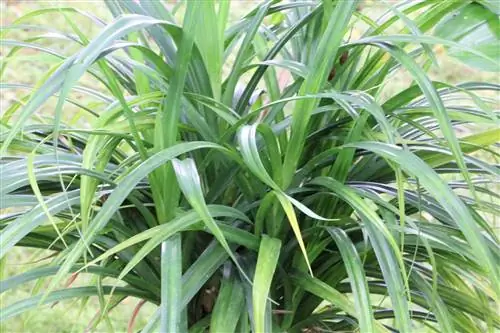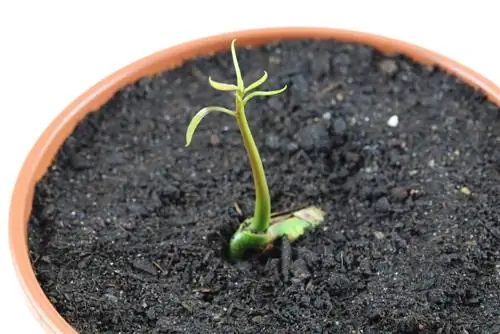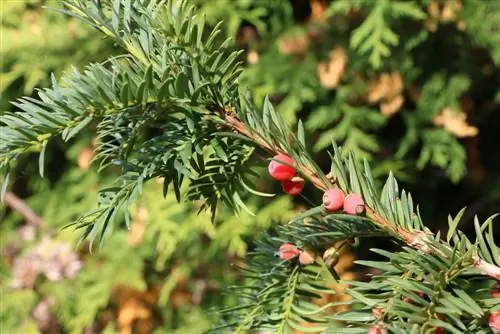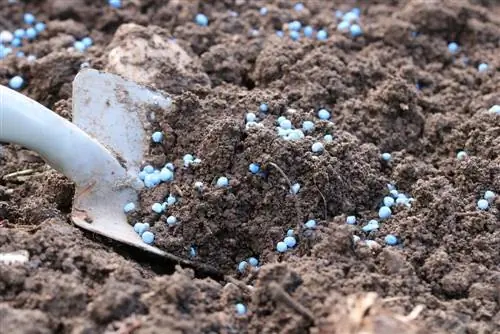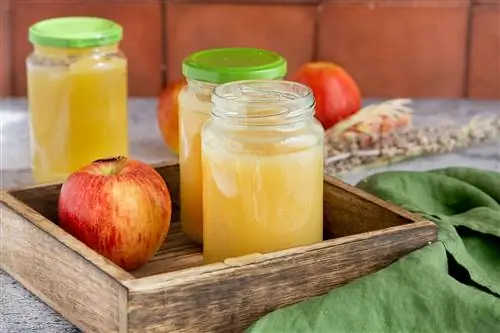- Author admin [email protected].
- Public 2023-12-17 03:39.
- Last modified 2025-06-01 06:48.
This genus is a seed plant and belongs to the screw tree family (Pandanaceae). The screw tree, also known as the screw palm, owes its name to the helical arrangement of its shiny leaves.
The Pandanus comes from the tropical forests of Africa, as well as from Madagascar and the Malay Archipelago. It forms a woody trunk that can grow over a meter. Its sword-shaped, stemless leaves grow like a palm tree and, depending on the species, can reach a length of two meters. From the age of around four years, so-called stilt or support roots grow that lift the plant. Under no circumstances should you try to plant the plant deeper.
Screw tree - species
There are more than 600 species. Most commonly seen is Pandanus veitchi i from Polynesia. It has narrow, toothed leaves with white-green stripes. The Pandanus sanderi from the Malay Archipelago has pointed, sharp teeth and yellow-green leaves. The Pandanus utilis from Madagascar is the largest of its genus and can grow up to two meters high. Its leaves are a solid blue-green and have red spines. It produces edible fruits. In addition, their leaves can be further processed into packaging material. The leaves of Pandanus amaryllifolius can also be used as a spice. To do this, simply cook one or more leaves and remove them before consumption.
Screw tree care
Light
The screw tree needs several hours of sun every day. A location that is bright all year round is therefore suitable. The more light the plant receives, the more clearly its leaf markings can be seen.
It is recommended to always leave it in the same place. It is particularly important to note that the species requires more and more space as it gets older. Their leaves also catch dust, which is why they should be dusted several times a year.
Temperature
The plant needs a room temperature of at least 18 °C. In summer you can also put them outside if you have a place protected from wind and weather. If the air is too dry, there is a risk that the edges and tips of the leaves will turn brown.
Pouring
You should always water abundantly so that the soil is always moist right down to the bottom of the pot. This prevents the roots from rotting due to a lack of oxygen when wet. However, the pot must not stand in water. During the winter rest period, you only water the screw tree a little and make sure that the soil does not dry out completely. Due to the often lack of humidity, the pandanus can be sprayed with water from time to time.
Fertilize
It can be fertilized three to four times a month from April to October. You can use a commercially available liquid fertilizer for this.
Soil / Substrate
You use a compost-based soil. The Pandanus does not place high demands on the plant substrate.
Repotting screw tree
In spring, repot the pandanus into slightly larger containers until the desired size is reached. It grows well in hydro containers, but plant containers with an irrigation system are even better. If you don't choose any of the options, you should use a heavy pot, otherwise the plant could tip to the side. The aerial roots of this mature seed plant often lift the plant so that it stands on stilts in the pot. When repotting, make sure that there is enough space between the soil and the edge of the pot. This is the only way the roots can develop sufficiently. For larger screw trees that are no longer repotted, add a little new, fresh soil in early spring and use it to cover all the roots that have emerged from the soil during the growth phase.
Cut Pandanus
In general, you don't have to cut much, but whole leaves keep dying on the outside while new ones form in the middle. These old leaves should be cut out as soon as they are completely dry. If you don't like the look of the brown leaves and don't want to wait until they dry out completely, you can always cut away the brown leaf tips. It is important that you always leave the last two centimeters green so as not to cut into the he althy tissue.
Propagation of the screw tree
The pandanus reproduces quite easily, namely by itself. It constantly forms small side shoots, which are cut off in early spring and planted individually in eight to ten centimeter high pots. The substrate should consist of equal parts of peat and sharp sand or perlite. Now put a plastic bag over the shoots and the container to create high humidity. Another option is a propagation box in which to place the young plants. A bright, not sunny place should be chosen as a location. When the young plants have rooted after about four to six weeks, they are slowly uncovered so that they gradually get used to the room air within two weeks. The plants should only be watered very lightly so that the upper layer of the soil dries out. After about a month, repot the plant into a larger pot with compost soil. It can now be treated like a fully grown screw tree.
Diseases and pests
With this robust plant, it often happens that the edges of the leaves turn brown and ultimately dry out. The reason for this is often that the air is too dry, which can also lead to lice. These settle in the area of the stilt roots and often go unnoticed until the consequences occur. To get rid of the lice, it usually helps to place the screw tree on pebbles in a bowl filled with water. Furthermore, cool temperatures and too much moisture can quickly lead to rotting roots.
What you should know about the screw tree in brief
The screw tree is very suitable as a houseplant because it is easy to care for and also extremely visually appealing. The only important thing is enough light and enough water during the summer. The pandanus is only recommended to a limited extent for families, as the toothed leaves can cause injury. So if you're looking for a decorative, easy-care and fast-growing plant, you'll be well served with a screw tree.
Young plants can be easily recognized by the teeth on the edges of the leaves, while old specimens can be easily confused with other genera due to their size. The German name screw tree refers to the rotation of the trunk around its longitudinal axis, while the Malay name “pandang” served as a reference for the scientific description. The genus Pandanus includes around 250 species, of which only a few are suitable as houseplants. All are upright growing shrubs and trees that, as they age, rise more and more above the ground on stilt-like roots.
The sword-shaped, strong leaves are extremely durable and strong. They are still used today by the last Stone Age indigenous people in the Eipomek high valley in New Guinea to cover the huts and can withstand even the strongest downpours. The pineapple-like fruits of several species were previously eaten, and the leaf juice was used internally in folk medicine for dysentery and externally to treat wounds. On the South Sea Islands, root and leaf fibers are made into baskets and mats and the thorny plants are used elsewhere as living fences to enclose gardens. Indoor cultivation usually only includes young plants of small species:
Care instructions
- A stand that is as bright as possible at the natural temperatures during the summer offers the best conditions for existence.
- However, direct sunlight must be avoided. Extremely dry air is not tolerated.
- Large containers for hydroponics, humidifiers or indoor fountains can help.
- Temperatures below 15°C and dry air when the temperature rises above 18°C lead to loss.
- You should therefore ensure a humidity of around 65 to 70%.
- The fast-growing plants require a nutrient-rich substrate: manure soil, clay, peat and sand (3:1:1:1).
- Hydroculture is very suitable if appropriately large containers are available.
- Consistent soil moisture can be guaranteed through regular watering
- and to meet the high nutrient requirements during the growing season by fertilizing with nutrient s alt solution (0, 19%) every 14 days.

